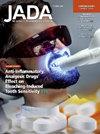退伍军人健康管理局牙齿不良事件分析
IF 3.5
2区 医学
Q1 DENTISTRY, ORAL SURGERY & MEDICINE
引用次数: 0
摘要
关于牙科患者安全的信息是有限的。很少有牙医在有事故报告的地方工作,因此,研究安全事件是一项挑战。作者分析了发生在退伍军人健康管理局(VHA)的牙科不良事件,这些事件上升到根本原因分析的水平。作者旨在确定最常见的不良事件,其原因,并建议采取措施。方法:作者检索了VHA国家数据库中从2021年1月1日到2024年11月18日的牙齿不良事件报告。如果他们发生在牙科诊所、手术室或护理机构,并且与手术或义齿有关,报告也包括在内。共有42份符合条件的报告。作者开发了一个代码本,根据主题出现的事件类型对根本原因分析进行定性分析。结果最常见的安全事故是手术部位错误(40.48%),其次是误食(19.05%)和使用消毒设备不充分(7.14%)。缺乏政策是不良事件最常见的原因,最建议采取的行动是制定或审查一项方案。结论VHA的一项分析显示,最常见的不良事件是手术部位错误。建议在普通公众中进行更多的研究来比较研究结果。实际意义作者提供了对不良事件本质的洞察,尽管由于报告仍然是自愿的,因此本研究存在局限性。研究结果应该鼓励讨论如何牙科诊所可以寻求改善病人安全和安全文化。本文章由计算机程序翻译,如有差异,请以英文原文为准。
An analysis of dental adverse events in the Veterans Health Administration
Background
Information on patient safety in dentistry is limited. Few dentists work in a place with incident reporting, thus, studying safety events is a challenge. The authors analyzed dental adverse events that rose to the level of root cause analyses that occurred in the Veterans Health Administration (VHA). The authors aimed to identify the most common adverse events, their causes, and recommended actions.
Methods
The authors searched the VHA national database for reports of dental adverse events from January 1, 2021, through November 18, 2024. Reports were included if they occurred in the dental clinic, operating room, or care facility and were related to a procedure or dental prosthesis. There were 42 eligible reports. The authors developed a codebook to qualitatively analyze the root cause analyses according to the event types that emerged thematically.
Results
The most frequently occurring safety incident was wrong-site surgery (40.48%), followed by ingestion (19.05%) and the use of inadequately sterilized equipment (7.14%). Lack of policy was the most common cause of adverse events and the action most recommended was to develop or review a protocol.
Conclusions
An analysis in the VHA revealed the most frequent adverse event was wrong-site surgery. Additional studies in the general public are recommended to compare findings.
Practical Implications
The authors provide insight into the nature of adverse events, although there are limitations to this study because reporting remains voluntary. The findings should encourage discourse on how dental offices can seek to improve patient safety and safety culture.
求助全文
通过发布文献求助,成功后即可免费获取论文全文。
去求助
来源期刊

Journal of the American Dental Association
医学-牙科与口腔外科
CiteScore
5.30
自引率
10.30%
发文量
221
审稿时长
34 days
期刊介绍:
There is not a single source or solution to help dentists in their quest for lifelong learning, improving dental practice, and dental well-being. JADA+, along with The Journal of the American Dental Association, is striving to do just that, bringing together practical content covering dentistry topics and procedures to help dentists—both general dentists and specialists—provide better patient care and improve oral health and well-being. This is a work in progress; as we add more content, covering more topics of interest, it will continue to expand, becoming an ever-more essential source of oral health knowledge.
 求助内容:
求助内容: 应助结果提醒方式:
应助结果提醒方式:


